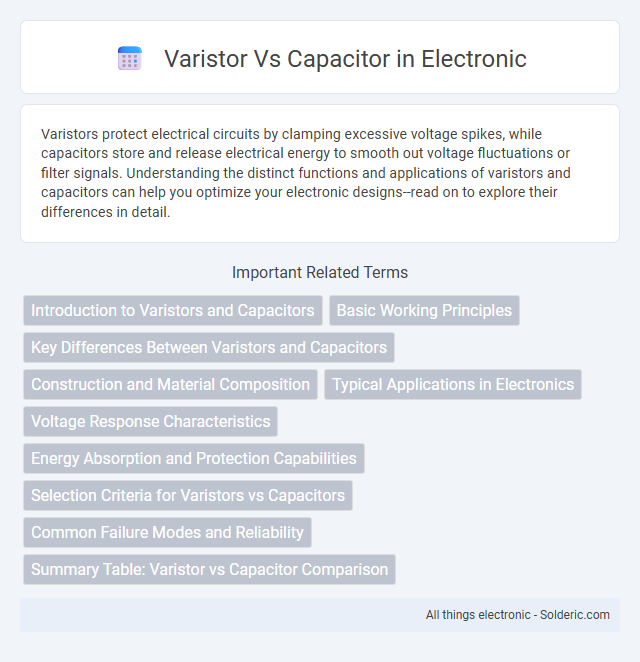Varistors protect electrical circuits by clamping excessive voltage spikes, while capacitors store and release electrical energy to smooth out voltage fluctuations or filter signals. Understanding the distinct functions and applications of varistors and capacitors can help you optimize your electronic designs--read on to explore their differences in detail.
Comparison Table
| Feature | Varistor | Capacitor |
|---|---|---|
| Function | Surge voltage protection | Energy storage and filtering |
| Component Type | Non-linear resistor | Passive two-terminal electrical component |
| Material | Metal oxide (typically ZnO) | Dielectric material between conductive plates |
| Operation | Clamps high voltage spikes by changing resistance | Stores and releases electrical charge |
| Application | Surge protection in power circuits and devices | Filtering, smoothing, timing, coupling in circuits |
| Response Time | Nanoseconds | Instantaneous charge and discharge at circuit level |
| Failure Mode | May short or degrade after large surges | Dielectric breakdown or leakage |
| Symbol | Varistor symbol (MOV) | Capacitor symbol |
Introduction to Varistors and Capacitors
Varistors are voltage-dependent resistors designed to protect circuits by clamping excessive voltage spikes, commonly used in surge protection applications. Capacitors store and release electrical energy by accumulating charge on their plates, playing a critical role in filtering, smoothing, and energy storage in electronic circuits. Both components serve distinct functions in managing electrical energy, with varistors primarily safeguarding against transient voltages and capacitors regulating energy flow and stability.
Basic Working Principles
A varistor operates by changing its resistance in response to changes in voltage, providing voltage clamping to protect circuits from transient surges. A capacitor stores electrical energy in an electric field between its plates and releases it when needed, smoothing voltage fluctuations and filtering signals. While varistors primarily safeguard against voltage spikes, capacitors stabilize voltage and energy flow in electronic circuits.
Key Differences Between Varistors and Capacitors
Varistors primarily function as voltage-dependent resistors that protect circuits from voltage spikes by clamping excessive voltage, while capacitors store and release electrical energy in the form of an electric field to smooth voltage fluctuations and filter signals. Varistors exhibit nonlinear resistance characteristics with a rapid change in resistance above a specific voltage threshold, whereas capacitors maintain a consistent capacitance value that determines their energy storage capacity. In terms of applications, varistors are integral to surge protection and transient voltage suppression, whereas capacitors are essential for energy storage, filtering, and signal coupling in electronic circuits.
Construction and Material Composition
Varistors are constructed using metal oxide semiconductor materials, primarily zinc oxide grains that form a ceramic matrix to provide nonlinear resistance, enabling efficient voltage clamping. Capacitors consist of two conductive plates separated by a dielectric material such as ceramic, polyester, or tantalum, storing and releasing electrical energy through an electric field. Your choice between these components depends on the application's need for voltage surge protection offered by varistors or energy storage and filtering provided by capacitors.
Typical Applications in Electronics
Varistors are primarily used for surge protection in electronic circuits, safeguarding sensitive components from voltage spikes caused by lightning or switching events. Capacitors serve diverse roles such as energy storage, signal filtering, decoupling, and timing applications in power supplies, communication devices, and analog circuits. While varistors protect against transient overvoltages, capacitors stabilize voltage levels and improve signal integrity in electronic systems.
Voltage Response Characteristics
Varistors exhibit a nonlinear voltage response, clamping voltage spikes by rapidly increasing resistance during high voltage surges, thereby protecting sensitive electronic circuits. Capacitors maintain a linear voltage response, storing and releasing energy based on the applied voltage within their rated limits, which stabilizes voltage levels but does not clamp surges. Your choice between a varistor and capacitor depends on whether transient voltage suppression or steady voltage regulation is required.
Energy Absorption and Protection Capabilities
Varistors excel in energy absorption by clamping high voltage surges and dissipating large transient energy, making them ideal for protecting circuits from sudden spikes. Capacitors, while capable of storing energy, primarily smooth voltage fluctuations and filter noise rather than absorb high-energy surges. Your choice between a varistor and a capacitor depends on whether you need rapid, high-energy surge protection or voltage stabilization and noise reduction.
Selection Criteria for Varistors vs Capacitors
Selection criteria for varistors versus capacitors focus on their distinct electrical properties and applications; varistors are primarily chosen for voltage clamping and surge protection due to their nonlinear resistance and ability to absorb high-energy transient spikes. Capacitors are selected for energy storage, filtering, and smoothing in circuits because of their linear capacitance and ability to store and release electrical charge. Your choice depends on whether you need transient voltage suppression or energy storage and filtering functions in your electronic design.
Common Failure Modes and Reliability
Varistors commonly fail due to repeated voltage surges causing degradation and eventual short circuits, while capacitors often suffer from dielectric breakdown, leakage current, or electrolyte evaporation leading to reduced capacitance and open circuit failures. Varistor reliability is impacted by transient surge energy and thermal stress, whereas capacitor reliability depends on voltage rating, temperature tolerance, and aging effects. Proper selection based on application-specific voltage and current requirements enhances lifespan and performance reliability for both components.
Summary Table: Varistor vs Capacitor Comparison
Varistors provide voltage-dependent resistance to protect circuits from voltage spikes, whereas capacitors store and release electrical energy to smooth voltage fluctuations or filter signals. Key differences include varistors' nonlinear response for transient suppression versus capacitors' linear energy storage for signal conditioning and power factor correction. Your choice depends on whether transient voltage protection or energy storage and filtering is required in the electrical system.
varistor vs capacitor Infographic

 solderic.com
solderic.com